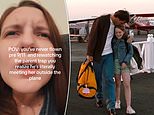
The glaring cultural divide between Gen Z and millennials has just been widened even further after young TikTok users voiced their shock at how lax air travel used to be before 9/11 – while calling on their elders to explain how plane journeys used to be.
A reaction to a scene from Lindsay Lohan’s 1998 movie The Parent Trap, which was posted to TikTok by user Aleks, embodies the bafflement of Gen Z at former air-travel norms.
In the clip, Annie, played by Lohan, gets off a plane after flying home from summer camp, and immediately spots her dad, played by Dennis Quaid, waiting for her right on the tarmac.
On watching the scene, Aleks squints in confusion at her TV, as text overlay reads: ‘POV: you’ve never flown pre 9/11 and rewatching the parent trap you realize he’s literally meeting her outside the plane.’
In a scene from 1998’s The Parent Trap, Lindsay Lohan’s Annie gets off a plane and is immediately greeted with the sight of her dad (Dennis Quaid) waiting for her on the tarmac
The dynamics of the airport scene proved baffling to Gen Z-ers, who grew up in a post 9/11 world – in which non-passengers can’t meet loved ones right at the gate
‘Millennials, was this the norm????’ TikToker Aleks implored in the caption of her post
‘Millennials, was this the norm????’ she implored in earnest in the caption.
And Aleks was not the only one to be left dumbfounded by the short scene – with dozens of her fellow Gen Zers taking to the comment section to express their own confusion.
‘Born in 2006; I always thought this was just a dramatic movie thing? I didn’t know that pre-9/11 you could actually do this,’ one person wrote.
‘OMG I thought they only did this in the movies,’ another chimed in, while a third commented: ‘I thought it was just because they were rich.’
Several older travelers also voiced fond memories of what airports and planes used to be like before the 9/11-inspired changes.
‘Pre 9/11 there wasn’t even TSA… my mom used to walk me straight to my gate and wait with me until my flight,’ one person recalled.
‘Pre 9/11 airports were practically just big bus stops,’ another wrote. ‘Practically no security, no complications, just a place you could chill while waiting for your flight.’
‘Can confirm that pre 9/11 flying my extended family would be outside waiting. Mainly smaller airlines did this,’ a third said.
While meeting on the tarmac would have varied by airport, it indeed used to be much easier for un-ticketed people meet friends or family getting of a plane right at the gates – or walk them right up to the gate in seeing them off.
As a result, many movies and TV shows filmed before the 9/11 attacks took place show a vastly different take on air travel than we are used to today.
After the terrorist attacks on September 11, 2001, airports across the world began implementing much stricter protocols across the board, completely transforming the way in which every aspect of air travel works – from check-in regulations to boarding procedures.
The TSA was established in the months immediately following 9/11
‘Before 9/11, security was almost invisible, and it was really designed to be that way,’ aviation security expert Jeff Price told NPR.
‘It was designed to be something in the background that really wasn’t that noticeable and definitely did not interfere with aircraft or airport operations.’
‘You could walk up to the gate at the very last minute. You did not have to have a boarding pass,’ he added.
‘All you had to do was go through the security checkpoint — no questions asked, no ID needed.’
With this, security simply consisted of a single metal detector.
There was no need to remove shoes, belts, or the like. Containers with liquid could be any size and laptops – although perhaps rarer additions to a carry-on back then – would not have to be removed from bags before going through security.
And, fatefully, box cutters, razer blades, and knives up to four inches long were allowed to be carried by passengers into the cabins of airplanes.
‘Even if the hijackers would have been caught with their knives prior to boarding the plane, the screeners would have handed it right back to them,’ Price explained to NPR.
The 9/11 hijackers were thought to have used box cutters or razer blades in taking over the cockpits of the three planes they hijacked.
By November 2001, George W. Bush signed into law the Aviation and Transportation Security Act, which established the Transportation Security Administration (TSA).
And it’s not just passengers who have been impacted by the dramatic changes to air travel safety and security.
In 2021 – 20 years after al-Qaeda terrorists flew two planes into the Twin Towers in New York – former United Airlines flight attendant Sara Nelson told the New York Times, ‘September 11th affects our jobs every single day,’ noting that a number of strict new training procedures were put into place as a result of the attacks.
Source link
CHECK OUT: Top Travel Destinations
READ MORE: Travel News



